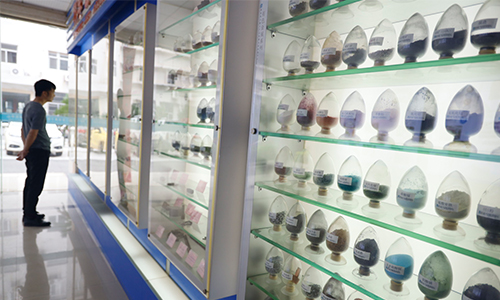Ventilators rely on rare earths
Global supply uncertainty shadows production of medical gear

A representative from local enterprises look at the display case of rare-earth metals and oxides at the National Center of Quality Supervision and Inspection for Tungsten and Rare Earth Products (NCQSIFTREP) in Ganzhou, East China's Jiangxi Province. Photo: Li Hao/GT
A prosperity index for China's rare-earth industry showed contraction for the first quarter, with rising prices and shrinking output, but analysts said annual output will be stable. Supplies of permanent magnets, a rare-earth product and raw material for making life-saving ventilators will meet market demand.
Rare-earth products are widely used to manufacture critical medical devices including ventilators, according to the Baotou Research Institute of Rare Earths. The best-known types of medical equipment are magnetic resonance imaging and computed tomography devices, which are made with rare-earth permanent magnetic materials.
According to data released on Monday, the prosperity index of China's rare-earth industry stood at 99.47 in the first quarter. A reading over 100 indicates expansion, while one reading below reflects contraction.
Output will increase in the second quarter as production was restarted after the coronavirus was brought under control. There is an annual quota in China, which remains stable these years, Yang Kunhe, chief metals and mining analyst at Pacific Securities, told the Global Times.
The quota was confirmed by a manager surnamed Yang at a large state-owned magnet maker based in Ganzhou, East China's Jiangxi Province. Yang told the Global Times on Tuesday that at present, the supply of rare earths can basically meet industrial demand, and China plans an increase of at least 12,000 tons for a total output of 132,000 tons this year.
Chen Zhanheng, an analyst at the Association of China Rare Earth Industry, told the Global Times on Monday that the annual domestic production capacity of neodymium iron boron, a raw material in permanent magnets, exceeds 300,000 tons.
In January and February, China's exports of rare-earth permanent magnetic products dropped 8.7 percent year-on-year, according to industry platform cnfeol.com.
"The decrease of exports in the first quarter should be attributed to reduced output in China caused by COVID-19. In the rest of the year, export volume will depend on overseas buyers, whose demand is expected to decline as manufacturing is choked by the pandemic. But China has sufficient supply for global demand, and as the biggest supplier of permanent magnets in the world, China has always exported these products," an analyst at cnfeol.com told the Global Times on Tuesday.
A Hebei Province-based rare-earth industry insider said that a small number of permanent magnets is necessary for each ventilator, and the minimum use could be 500 grams. Other rare-earth products, including ferrosiliconmagnesium alloy, lanthanum and ytterbium, are also used in medical equipment.
While permanent magnets made from rare earths will not be a headache for ventilator makers and other medical equipment producers, business insiders worry about supplies on the industry chain, affected by the COVID-19 pandemic. A ventilator is assembled from hundreds of parts in a supply chain that typically spans several continents.
A Beijing-based medical equipment industry insider close to one of the biggest ventilator producers in China told the Global Times on condition of anonymity that the enterprise has nearly 100 direct domestic and overseas suppliers.
A Global Times source in an invasive ventilator manufacturing company, who declined to be identified, also said that parts for making a ventilator come from global suppliers, and the critical parts are only available from some countries including the US, Japan, Germany and Switzerland.
According to the source, the pandemic has posed uncertainties for suppliers, resulting in lengthened delivery time. "Some critical parts are only available from certain countries. For example, a specific part is only available in Japan, so almost every ventilator maker in the world will have to purchase it from Japan, which, amid the pandemic, has caused huge pressure on their production capacity."
"Suppliers used to inform us with the fixed shipping date, but now they would say 'this order will be delayed due to the impact brought by the pandemic,'" the source said, adding that the situation has lengthened their delivery time as new orders for invasive ventilators has been scheduled to August or later.
Although global uncertainties about supplies make medical manufacturers anxious, and the labor-intensive industry is at risk amid the spread of COVID-19, Chinese ventilator manufacturers are in full swing.
"Chinese ventilator brands, on the premise of first meeting domestic needs, have also begun to aid the international community," Zhang Xun, a senior analyst of the ventilator industry, told the Global Times on Monday.
"China's medical ventilator market was in the primary stage 17 years ago amid the SARS outbreak. There was a serious supply shortage, which was mainly met by imported brands," said Zhang.